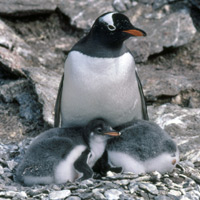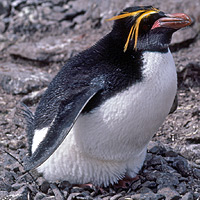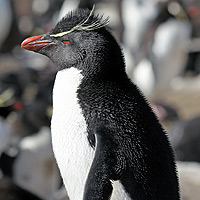Of 17 penguin species worldwide, 7 are found in Antarctica, 4 of these live and nest on and around the Antarctic continent and a further 3 live and nest on Antarctic and sub-Antarctic islands.
Antarctic Penguins Facts
All 17 penguin species live exclusively in the Southern Hemisphere apart from the Galapagos penguin which just about qualifies as living in the Northern Hemisphere as it spans a narrow band at the equator in the Galapagos Islands.
True Antarctic species, breed on or near continental Antarctica
Adelie penguin
Pygoscelis
adeliae
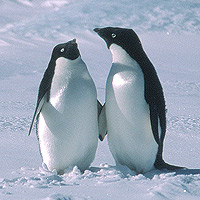
Height: 70cm -
27.5inches
Weight: 5kg - 11lb
Breeding Season:
November - February
Distribution:
Antarctic continent and sub-Antarctic
islands.
The second most southerly breeding penguin
species
Estimated population:
2.5 million
breeding pairs
Chinstrap penguin
Pygoscelis
antarctica
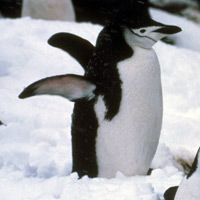
Height: 68cm -
27 inches
Weight: 4.5kg - 10lb
Breeding Season:
December - March
Distribution:
Sub Antarctic and Antarctic
islands, Antarctic Peninsula.
Estimated population:
5 million breeding pairs
Emperor penguin
Aptenodytes
forsteri
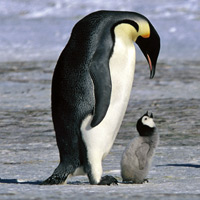
Height: 1.15m
- 3.8ft
Weight: 30kg - 66lb
Breeding Season:
April - December
Distribution:
Continental Antarctica on the
sea-ice, the most southerly of all species of penguins.
Estimated population:
238, 000 breeding pairs,
595, 000 individuals
Sub-Antarctic species, furthest south is the sub-Antarctic islands
King penguin
Aptenodytes
patagonica
Height: 95cm - 3.1 ft
Weight: 15kg - 33lb
Breeding
Season:
Starts in November or January, complex
breeding system, early or late breeders - raise 2 chicks
every 3 years.
Distribution:
sub-Antarctic islands 46° to 55° South.
Biggest colony is on South Georgia.
Estimated
population:
2 to 3.2 million breeding pairs
Macaroni penguin
Eudyptes
chrysolophus
Height: 68cm - 27 inches
Weight: 4.5kg - 10lb
Breeding
Season:
December - March
Distribution:
Sub-Antarctic islands especially Heard island
and South Georgia
Estimated population:
9 million breeding pairs.
Many populations are in
decline.
Rockhopper penguin
Eudyptes
crestatus
Height: 55cm - 21.6 inches
Weight: 2.5kg - 5.5lb
Breeding Season:
December - March
Distribution:
Falkland islands and sub-Antarctic
islands north of the Antarctic convergence.
Estimated population:
1.8 million breeding
pairs
Many populations are in decline by 40% and
up to 94% for certain colonies.
Penguin adaptations to living in Antarctica
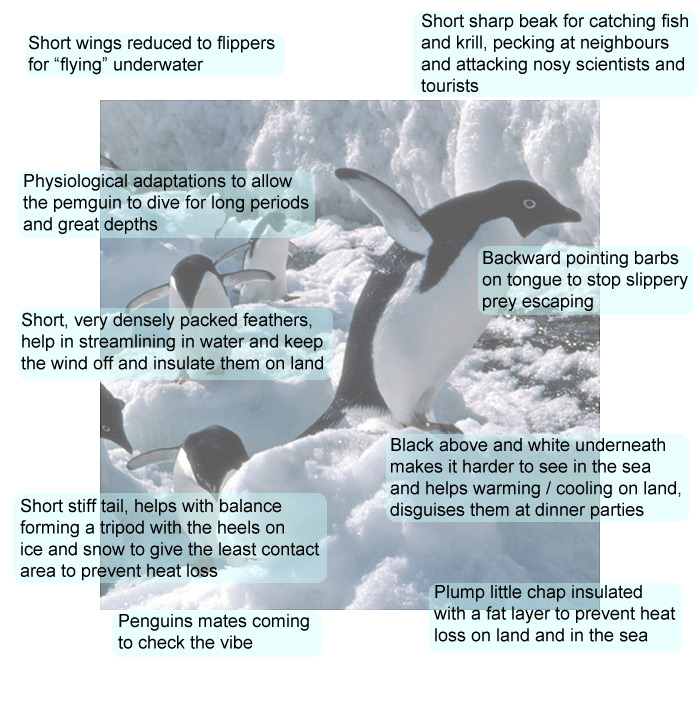
-
Waddling and energy savings - If you've ever seen a penguin walking, you'll have seen it moves along with rather a comical motion swaying from side to side with each step like an upside down pendulum. This is a consequence of being a tall top-heavy animal with short legs. Recently studies have found that this is actually a very efficient way of walking with the swaying motion leading to an 80% energy saving compared to a more static walk. They can move quicker and more efficiently out of the water by "tobogganing" on slippery icy or snowy surfaces, they lie down on their front and push themselves with their feet, using strong toes and claws to get a grip, in this way they can outpace a running human. Unlikely as they look, penguins ways of moving themselves on land are effective enough to cover 100km or more at times if cold weather freezes the sea between the open water and their nest site.
-
Penguins can come out of the sea onto rocky shores or slippery ice during rough weather - strong claws that can grip on to slippery surfaces efficiently make this look far easier than it is.
-
Smaller penguins "bounce" - Small size means less kinetic energy if the penguins are thrown around and so less damage. The smaller penguin species can come out of crashing waves and rough seas on inhospitable, difficult rocky shores without being smashed to pieces precisely because they are small and so don't have so much kinetic energy if bashed against a rock, an inherent toughness and blubber padding helps too. Larger penguins wouldn't do so well.
-
Feet pulled in when swimming - like an aircraft pulling in its landing gear to reduce air resistance, penguins pull their feet close to their bodies when swimming for maximum streamlining and drag reduction. However when needed they can be used like a water-brake, stuck out at the right moment, a penguin can use its feet to make a 180° turn in 1/5th of a second.
-
Elbow and wrist joints are fused - this gives a more rigid forelimb that is developed into a paddle (flipper) for swimming underwater.
-
Collect air in their feathers by preening - like many other birds, penguins spend a lot of their time preening their feathers, much of this is to fluff the feathers out and so collect air amongst them, this is done particularly before going to sea. There are two benefits, firstly it aids insulation and secondly when the penguin swims particularly quickly this air is released as micro-bubbles which lubricates the penguins path through the water, so reducing drag. It has been shown that penguins can leave the water in a burst of speed in this manner that is twice their theoretical swimming speed without it. Particularly useful if being pursued by a predator or if a jump to extra height is needed to get onto the ice and out of the water.
-
Nest building - All but king and emperor penguins build a nest, though they are usually only a simple pile of stones that are continually stolen and swapped between the members of a colony when the owners aren't looking. The nests are slightly higher than the surrounding land so that if the temperature rises and the snow melts, the nest is not flooded. Emperor and King penguins keep the egg and then the young chick on their feet covered by a brood pouch until they are large enough to regulate their own temperature.
-
Breeding Colonies - Penguin colonies are very loud, raucous, busy and smelly affairs. The call of all penguins is as musical and gentle as a braying jackass and the whole colony is usually awash with penguin guano (posh word for bird poop). When I was in Antarctica one thing I did was help with long-term surveys which entailed walking through the colony (terribly frowned upon these days). Each nest is just over two pecking distances apart so the penguins can't reach each other. Of course walking through the middle meant that you were in range of everyone. I used to worry a lot about slipping over in a penguin colony, covered from head to toe in guano and pecked mercilessly.
-
Reproduction - Colonies may be of just a handful of breeding pairs or up to half a million birds and more. Many species lay two eggs, though it is rare that two chicks are raised, if food is short it will be fed to the biggest and strongest only. Male and female parents share egg and chick duty. Chicks are fed regurgitated fish and krill (yum!). The chicks leave the nest (or parents feet) when they are large enough to keep their own temperature constant, they form creches to give each other mutual support and protection from marauding skuas and also to protect against the cold and wind.
-
Predators - Penguins main predators are leopard seals (the main predators of adult birds) and Skuas (the main predators of eggs and unguarded chicks).
Penguins and cold adaptations in detail
Picture credits: Top banner - Christopher Michel, CC BY 2.0 licence / Emperor penguin - Warner Brothers / King penguin - Mike Usher / Rockhopper penguin - Liam Quinn from Canada, Creative Commons 2.0 Share and share alike license

